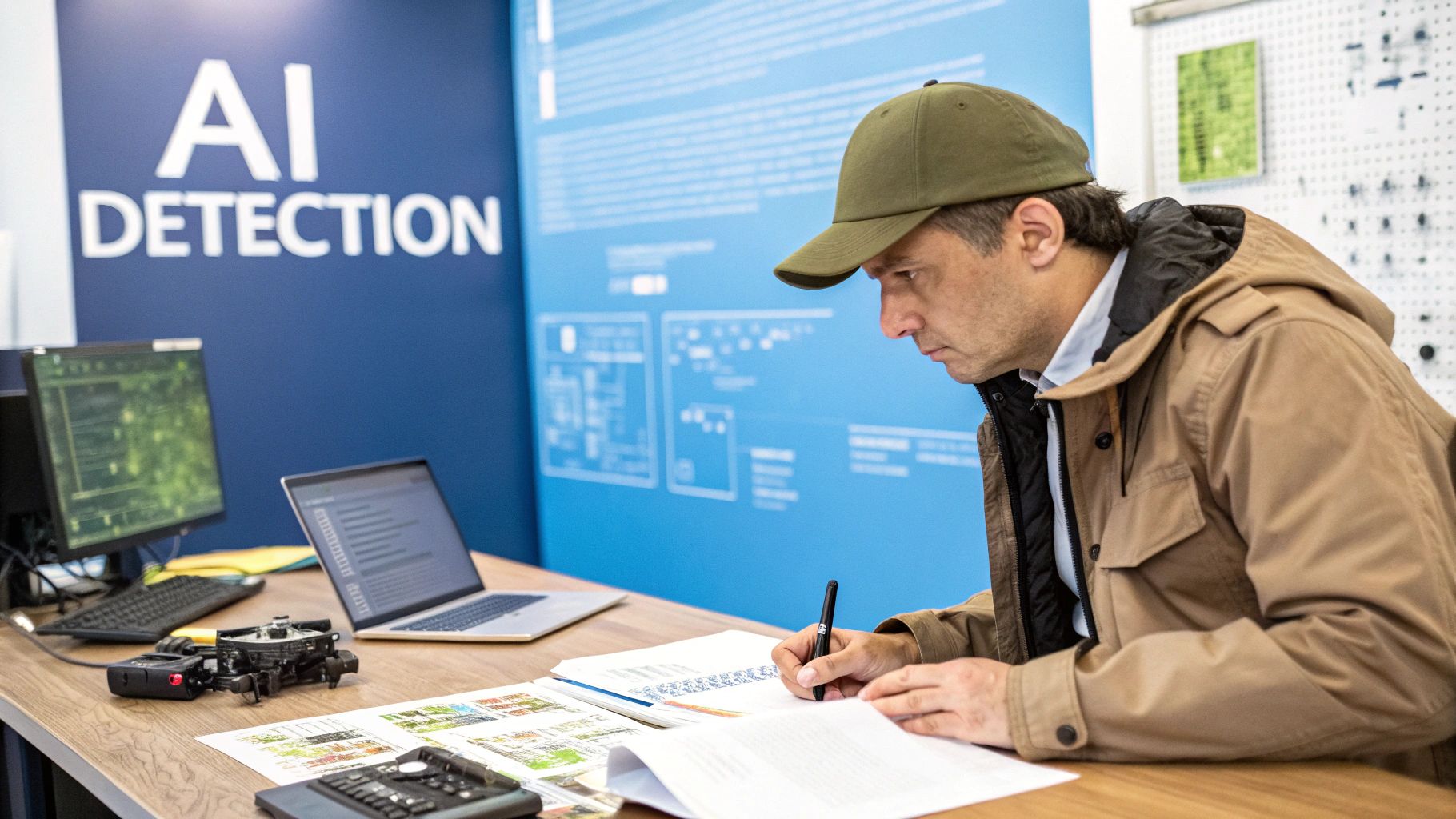Understanding How AI Detection Really Works

AI detection works by examining specific patterns and characteristics in written text. Modern detection tools use Natural Language Processing (NLP) algorithms to analyze content and identify signs that suggest machine authorship. These tools go beyond basic plagiarism checking to examine writing style, structure, and subtle language patterns that set AI-generated text apart from human writing.
How NLP Algorithms Identify AI-Generated Text
The foundation of AI detection lies in analyzing text predictability. While AI writing systems produce coherent text, they often fall into noticeable patterns based on their training data. For instance, they might repeatedly use certain transition phrases or maintain similar sentence structures throughout a piece. These repetitive elements may not be obvious to casual readers but become clear signals to NLP detection algorithms. Just as a detective notices small inconsistencies in statements, AI detection tools pick up on these subtle but telling patterns.
Sentiment Analysis and AI Detection
The emotional component of writing provides another key indicator for AI detection. When humans write, they naturally include emotional undertones and nuances, even in formal text. AI systems often struggle to replicate this authentic emotional expression, producing content that may be technically correct but lacks genuine feeling. Consider how an AI might write a heartfelt message – while the words may be appropriate, the emotional depth often falls short. This disconnect between content and authentic emotional expression helps detection tools identify machine-written text.
The Role of Perplexity and Burstiness in Detecting AI Writing
Two specific metrics help detection tools evaluate text: perplexity and burstiness. Perplexity measures how random or unexpected the text appears, with AI-generated content typically showing lower scores due to its more predictable nature. Burstiness examines how sentence length and structure vary throughout the text. Human writers naturally mix short and long sentences, creating a more dynamic flow. AI writing tends to maintain more consistent sentence patterns. Think of how people speak – they might use a quick "Yes!" followed by a detailed explanation, while AI tends to keep a more uniform style throughout.
These combined approaches allow detection tools to identify AI-generated content with increasing accuracy. However, it's important to note that these tools aren't perfect. As AI writing technology continues to develop, detection methods must also evolve and improve to stay effective. This ongoing development reflects the dynamic nature of both AI writing and detection capabilities.
Choosing Detection Tools That Actually Work
Finding reliable AI content detection methods has become essential as AI writing tools grow more common. But selecting the right detection tool requires careful thought and evaluation. Instead of picking the first option available, you need to assess tools based on your specific requirements and understand what each detection method can and cannot do.
Evaluating AI Detection Tools: Key Considerations
When evaluating AI detection tools, accuracy should be your top priority. A tool that frequently misidentifies human writing as AI-generated (false positives) or fails to catch AI content (false negatives) will waste time and create unnecessary headaches. Look closely at what types of AI writing each tool is designed to detect – some focus on specific AI models while others take a broader approach.
The tool's interface and workflow integration are also important factors. Even powerful detection capabilities won't help if the tool is frustrating to use or doesn't fit smoothly into your content process. Consider practical aspects like pricing plans and available support options. The best tool combines strong detection abilities with an interface that makes sense for your team.
Comparing Leading Solutions: Copyleaks and Originality.AI
Among the top AI detection options, Copyleaks and Originality.AI stand out. Copyleaks achieves over 99% accuracy in identifying AI text, with just 0.2% false positives. It uses advanced pattern analysis to spot machine-generated content, though some users report occasional inconsistencies. Originality.AI excels at detecting hybrid content that mixes human and AI writing, providing detailed breakdowns of potentially AI-generated sections. You might be interested in: How to master content checking at SmartStudi.
Combining Detection Methods for Maximum Accuracy
Many content teams find that using multiple detection tools together provides the most reliable results. A common approach is to run content through two or more AI detectors and have human editors review flagged sections. This layered strategy helps overcome the limitations of individual tools while ensuring thorough content verification. Having multiple checkpoints reduces the risk of AI content slipping through undetected.
The Future of AI Detection
AI writing detection continues to develop as AI writing models grow more advanced. Detection tools must constantly improve to keep pace with new AI capabilities. This means the effectiveness of current detection methods may shift over time. Content professionals should stay informed about developments in both AI writing and detection technology to maintain strong verification processes. The ability to accurately identify AI-generated content will remain crucial as these technologies continue to evolve.

Mastering the Art of Manual Detection
Reading and identifying AI-generated text requires skills beyond what automated tools can provide. While detection software makes a good starting point, developing your own discernment is essential for spotting the subtle signs that machines leave behind. Much like how an experienced editor sees beyond basic grammar to evaluate the quality of writing, manual detection allows you to recognize the deeper patterns and limitations in AI-generated content.
Recognizing the Subtle Markers of AI-Generated Text
The writing patterns of AI often follow predictable formulas that give them away. Watch for repetitive sentence structures and an overreliance on common transition phrases like "in addition," "moreover," or "on the other hand." While these phrases work well occasionally, their frequent use suggests machine authorship. AI text also tends to maintain an unusually consistent tone throughout, lacking the natural variation in vocabulary and style that characterizes human writing, even when attempting creative or persuasive pieces.
Contextual Inconsistencies and Logical Fallacies
Pay close attention to how ideas connect and flow together. Since AI generates text based on statistical patterns rather than true comprehension, it often produces content that seems reasonable at first glance but falls apart under closer inspection. For example, when writing about historical events, AI might accurately state individual facts but fail to weave them into a coherent narrative that makes sense. This gap between surface-level accuracy and deeper understanding is a key weakness that manual review can identify.
Practical Exercises for Sharpening Your Detection Skills
To build your manual detection abilities, start by comparing known AI text samples with human writing on similar topics. Study them side by side to spot the telling differences in style, flow and emotional resonance. Focus particularly on the emotional depth – or lack thereof – in the writing. AI typically struggles to capture genuine feeling and nuance, producing text that feels emotionally flat or artificial, similar to how synthetic voices lack natural warmth. Regular practice analyzing these differences will strengthen your ability to identify AI content accurately and efficiently. This skill grows more valuable as the line between human and machine-written text continues to blur.
Building a Reliable Detection Workflow

Creating an effective system for detecting AI writing requires both smart tools and human judgment working together. When these two elements work in harmony, content teams can check content accurately and efficiently at scale. This balanced approach helps teams stay ahead as AI writing continues to advance.
Establishing Clear Detection Criteria
The foundation of any good detection system starts with defining specific standards. Teams need clear guidelines about what counts as AI-generated content in their organization. These standards might include specific metrics like perplexity scores or common AI writing patterns. For example, a team could set a rule that any content scoring below a certain perplexity threshold needs another look. Having these clear benchmarks helps everyone evaluate content consistently.
Integrating Automated Tools into Your Process
Smart software plays a key role in making detection more efficient. Tools powered by natural language processing can quickly scan large amounts of text and flag potential AI content for review. For instance, Copyleaks can analyze text and show how likely it is to be AI-generated. However, these tools work best as a first step rather than the final word. You might be interested in: How to master content checking at SmartStudi.
The Importance of Human Review in AI Detection
While automated scanning provides a good starting point, having experienced editors review the results is essential. Human reviewers can spot subtle signs of AI writing that algorithms often miss. They understand context and can identify issues like faulty logic or inconsistent details that tools may overlook. This human element provides vital quality control to ensure both speed and accuracy in the detection process.
Developing a Scalable Workflow for Mixed Content
Content that combines human and AI writing needs special attention. A good approach is to use multiple detection tools together and focus human review on sections where the tools disagree. For example, a team might run text through both Copyleaks and Originality.AI, then have editors carefully check any passages that only one tool flags. This layered method helps teams work efficiently while still catching AI content effectively. As AI writing tools get better, having multiple checkpoints becomes even more important.
Navigating Complex Detection Scenarios
After exploring manual and automated detection approaches, let's examine how to identify AI writing in more challenging scenarios. These situations require combining multiple methods to achieve accurate results. Here's how to tackle some of the most common complex cases.
Deciphering Heavily Edited AI-Generated Content
One major challenge is spotting AI text that has undergone extensive human editing. When writers carefully revise AI output by restructuring sentences, adding varied vocabulary, and improving the flow, it becomes much harder to detect the original AI source. Think of it like an old painting that's been restored – the original artist's technique gets obscured under new layers, making attribution difficult. Standard detection tools often struggle with these hybrid texts that blend AI and human elements.
Identifying Partially AI-Generated Content
Mixed content, which combines human writing with AI-generated sections, presents another tricky scenario. Writers increasingly use AI tools to draft certain parts while writing others themselves – for example, using AI to create product descriptions within a larger human-written article. Detecting this partial AI usage requires examining the text at a granular level to identify which specific sections came from AI versus a human writer. Success depends on using both automated tools and careful human review to spot subtle differences between the sections.
Reducing False Positives and Increasing Confidence
False positives – incorrectly flagging human text as AI-generated – remain an ongoing challenge. To minimize these errors, it's essential to use multiple detection methods rather than relying on a single tool or metric. Consider the writing context too, since certain styles like technical or academic writing may share characteristics with AI text that can mislead detection tools. By evaluating content through multiple lenses and understanding its purpose and context, you'll catch more AI content while reducing false flags.
Developing a Decision Framework for Difficult Cases
A structured process helps ensure consistent, accurate results when evaluating challenging content. Start with automated scans, then escalate unclear cases for detailed human review focused on coherence, logical flow, and emotional resonance. For example, if multiple detection tools flag potential AI content but the writing shows human characteristics, have an editor carefully examine the full context and writing style. Having clear steps for handling ambiguous cases leads to more reliable detection results over time.
Staying Ahead of AI Writing Evolution

AI writing technology is advancing rapidly, with new capabilities and models emerging all the time. To effectively identify AI-generated content, we must commit to continuously learning and adapting our detection methods. The tools and techniques that worked yesterday may not be as effective tomorrow, making it essential to stay current with the latest developments in both AI writing and detection.
Adapting to Emerging Trends in AI Writing
Understanding recent advances in AI writing technology is critical for effective detection. Modern AI models can now mimic human writing patterns with increasing skill, which means we can't rely only on looking for obvious patterns or awkward phrasing. These models now generate everything from tweets to academic papers, requiring us to develop more nuanced detection approaches for different content types. For example, while an AI might excel at producing structured business reports, it may still struggle with creative storytelling or complex analytical pieces.
Refining Detection Strategies for Evolving AI Models
Our detection methods need to grow alongside AI capabilities. While basic techniques like checking for repetitive language still have value, we're moving toward more sophisticated analysis methods. For instance, examining logical flow, argument coherence, and original thinking has become increasingly important. Rather than focusing solely on surface-level markers, effective detection now requires a deeper understanding of how ideas connect and develop throughout a piece of writing. This shift toward comprehensive analysis helps identify even highly polished AI-generated content.
The Role of Human Expertise in a Changing Landscape
Human judgment remains irreplaceable in identifying AI-written content, even as automated detection tools improve. Experienced reviewers can spot subtle clues that machines miss – like unique perspectives, authentic emotional depth, or creative connections between ideas. Much like an art expert can distinguish between an original painting and a skilled copy, trained professionals can often sense when writing lacks genuine human insight. Check out our guide on enhancing your content with AI detection at SmartStudi.
Building Sustainable Detection Practices
Creating lasting success in AI detection requires a well-planned approach. Organizations should focus on training their content reviewers, combining human expertise with AI tools effectively, and keeping up with new developments in the field. Clear processes for evaluating suspected AI content help ensure consistent results across different reviewers and situations. This systematic approach helps maintain content quality while adapting to new challenges in AI writing detection.
SmartStudi offers comprehensive AI tools designed to empower students in their academic pursuits. From AI detection and plagiarism checkers to text paraphrasing and essay generation, SmartStudi provides a suite of resources to enhance writing skills and academic integrity. Explore SmartStudi today and discover how these tools can help you achieve your academic goals.
